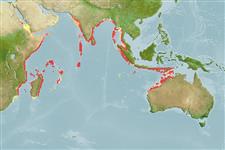Environment: milieu / climate zone / distribuzione batimetrica / distribution range
Ecologia
marino; acqua dolce; salmastro benthopelagico; catadromo (Ref. 51243). Tropical; 23°N - 33°S
Asia: Pakistan, India, Sri Lanka, Burma, and the East Indies. Reported from Nepal (Ref. 9496, 12045) and Bangladesh (Ref. 1479).
Size / Peso / Age
Maturità: Lm ? range ? - ? cm
Max length : 200 cm TL maschio/sesso non determinato; (Ref. 85009); common length : 80.0 cm TL maschio/sesso non determinato; (Ref. 4832); peso massimo pubblicato: 6.0 kg (Ref. 1479)
Short description
Chiavi di identificazione | Morfologia | Morfometria
Raggi dorsali molli (totale) : 250 - 305; Raggi anali molli: 220 - 250; Vertebre: 106 - 112. Body elongate, head conical, flattened dorsally. Mouth terminal, lips prominent, narrow bands of teeth on jaws, broad band on vomer.
Body shape (shape guide): eel-like.
Lives in freshwaters, but also occurs in estuaries and in the sea during early life and near maturity (Ref. 4832). Occurs in freshwater streams, pools and reservoirs and commonly found in mud substrates of tanks and in deep rock pools of rivers (Ref. 41236). Most common eel in Indian inland waters. There exists a good export market for both live elvers and eels. Highly prized as food fish because of its nutritional value. Fish mucous from live fish mixed with rice or wheat flour is used as medicine for arthritis (Ref. 44150).
Life cycle and mating behavior
Maturità | Riproduzione | Deposizione | Uova | Fecundity | Larve
Talwar, P.K. and A.G. Jhingran, 1991. Inland fishes of India and adjacent countries. vol 1. A.A. Balkema, Rotterdam. i-liv + 1-541, 1 map (Ref. 4832)
IUCN Red List Status (Ref. 130435: Version 2025-1)
Threat to humans
Harmless
Human uses
Pesca: commerciale; Acquacoltura: probabile utilizzo futuro; Pesce da pesca sportiva: si
Strumenti
Special reports
Download XML
Fonti Internet
Estimates based on models
Preferred temperature (Fonte Biblio.
123201): 26.2 - 29.3, mean 28.3 °C (based on 292 cells).
Phylogenetic diversity index (Fonte Biblio.
82804): PD
50 = 0.5000 [Uniqueness, from 0.5 = low to 2.0 = high].
Bayesian length-weight: a=0.00076 (0.00037 - 0.00157), b=3.17 (3.00 - 3.34), in cm total length, based on LWR estimates for this Genus-body shape (Ref.
93245).
Trophic level (Fonte Biblio.
69278): 3.8 ±0.7 se; based on size and trophs of closest relatives
Resilienza (Fonte Biblio.
120179): Molto basso, tempo minimo di raddoppiamento della popolazione più di 14 anni (Preliminary K or Fecundity.).
Fishing Vulnerability (Ref.
59153): Very high vulnerability (90 of 100).
🛈
Nutrients (Ref.
124155): Calcium = 25.7 [12.9, 56.8] mg/100g; Iron = 0.5 [0.3, 0.9] mg/100g; Protein = 18.2 [16.3, 20.3] %; Omega3 = 0.246 [0.109, 0.567] g/100g; Selenium = 184 [71, 424] μg/100g; VitaminA = 20.6 [3.6, 106.6] μg/100g; Zinc = 0.956 [0.596, 1.561] mg/100g (wet weight);
